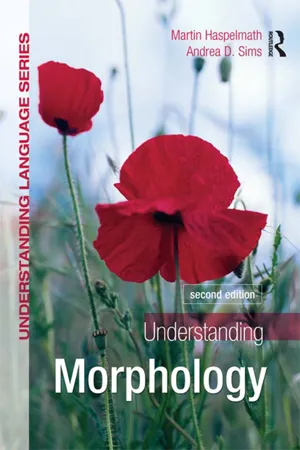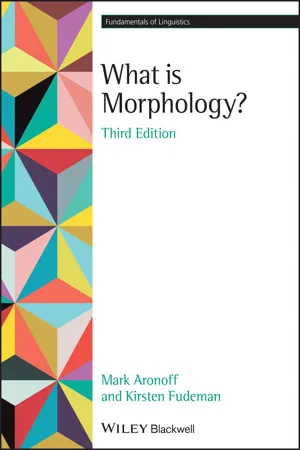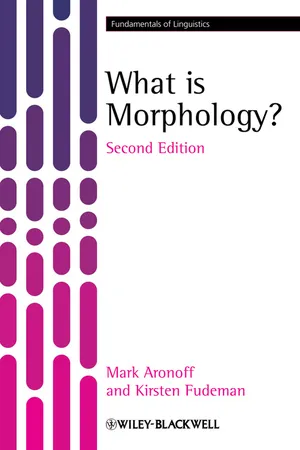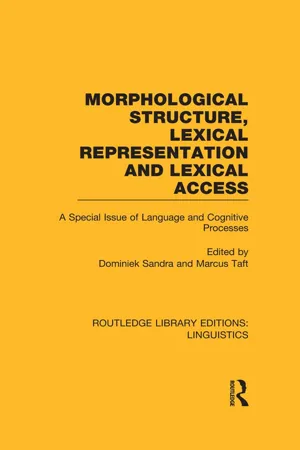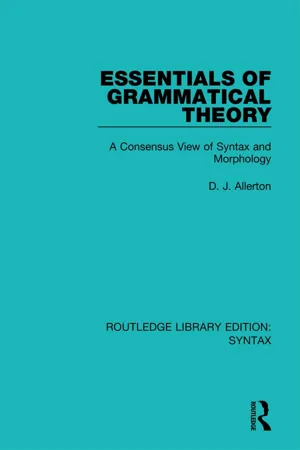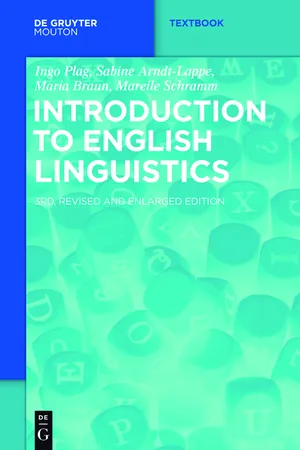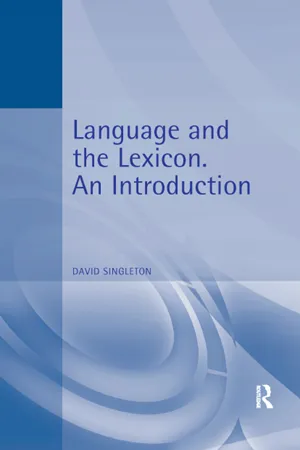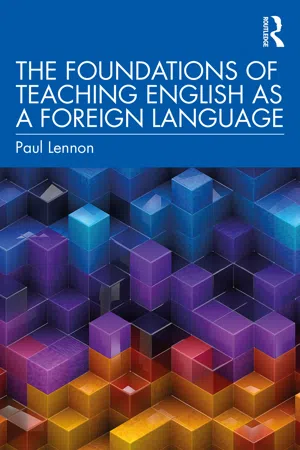Languages & Linguistics
Lexeme
A lexeme is the basic unit of meaning in a language, representing a single word or a set of inflected forms with the same meaning. It encompasses all the different forms a word can take, such as its base form, plurals, verb tenses, and so on. Lexemes are essential for understanding the structure and meaning of words within a language.
Written by Perlego with AI-assistance
Related key terms
8 Key excerpts on "Lexeme"
- eBook - ePub
- Martin Haspelmath, Andrea Sims(Authors)
- 2013(Publication Date)
- Routledge(Publisher)
monomorphemic. Morphemes are the ultimate elements of morphological analysis; they are, so to speak, morphological atoms.In this chapter we introduce some other fundamental concepts and their related terms, starting with Lexemes and word-forms.2.1 Lexemes and word-forms
The most basic concept of morphology is of course the concept ‘ word’ . For the sake of convenience, let us assume for the moment that a word is whatever corresponds to a contiguous sequence of letters.2 Thus, in one sense the first sentence of this paragraph consists of twelve words, each separated by a blank space from the neighbouring word(s). And in another sense the sentence has nine words – there are nine different sequences of letters separated by spaces. But when a dictionary is made, not every sequence of letters is given its own entry. For instance, the words live, lives, lived and living are pronounced differently and are different words in that sense. But a dictionary would contain only a single entry LIVE . The dictionary user is expected to know that live, lives, lived and living are different concrete instantiations of the ‘ same’ word live. Thus, there are three rather different notions of ‘ word’ . When a word is used in some text or in speech, that occurrence of the word is sometimes referred to as a word token. In this sense the first sentence in the paragraph consists of twelve words. The other two senses of the term ‘ word’ are not defined in reference to particular texts; they correspond to the ‘ dictionary word’ and the ‘ concrete word’ . Since this distinction is central to morphology, we need special technical terms for the two notions, Lexeme and word-form, respectively.A Lexeme is a word in an abstract sense. live is a verb Lexeme. It represents the core meaning shared by forms such as live, lives, lived and living. In most languages, dictionaries are organized according to Lexemes, so it is usually reasonable to think of a Lexeme as a ‘ dictionary word’ . Although we must assign names to Lexemes to be able to talk about them, Lexemes are abstract entities that have no phonological form of their own. LIVE is therefore just a convenient label to talk about a particular Lexeme; the sequence of sounds [lIV - eBook - ePub
- Mark Aronoff, Kirsten Fudeman(Authors)
- 2022(Publication Date)
- Wiley-Blackwell(Publisher)
In addition, we can label them as different grammatical words (discussed in section 2.1.3) because each plays a distinct grammatical role within a sentence. But at some level these different words are all tokens of the same type. They mean the same thing, and no one would expect a dictionary to give them four separate entries. We must be dealing with a single Lexeme, but one that happens to be realized in several different forms, depending on grammatical context. This example shows you that a Lexeme is not a single form, but rather a set of forms. [Exercises 6–7] What is a Lexeme? A Lexeme is a theoretical construct that corresponds roughly to one of the common senses of the term word. Examples include BOOK, EAT, DARK, SECRETLY. It is a sign or set of signs that exists independently of any particular syntactic context. It has a particular meaning or grammatical function (e.g., ‘a set of written or printed pages fastened along one side and encased between two covers’ for BOOK). Some linguists restrict the class of Lexemes to the major lexical categories of noun, verb, adjective/adverb. It is generally referred to by its citation form (e.g., BOOK, EAT), but its shape may vary systematically according to the syntactic context in which it is used (e.g., one book, two books ; I am eating right now, I ate a big dinner yesterday). We have already said that in order to talk about Lexemes, morphologists give them each a name, and by convention, they put these names in small capital letters. In reality the name of a Lexeme is much more than a name. In English it also happens to be the Lexeme’s lexical stem. The lexical stem is the form of the Lexeme that is most often used in the creation of new words. To illustrate what we mean by lexical stem, let’s look closely at the Lexeme GO. This Lexeme has five forms, two of them irregular: go, goes, went, gone, going. Of these forms, go has a different status from the rest - eBook - ePub
- Mark Aronoff, Kirsten Fudeman(Authors)
- 2011(Publication Date)
- Wiley-Blackwell(Publisher)
But at some level these different words are all tokens of the same type: they mean the same thing and no one would expect a dictionary to give them four separate entries. We must be dealing with a single Lexeme, but one that happens to be realized in several different forms, depending on grammatical context. This example shows you that a Lexeme is not a single form, but rather a set of forms. [Exercises 6–7] What is a Lexeme? A Lexeme is a theoretical construct that corresponds roughly to one of the common senses of the term word. Examples include BOOK, EAT, DARK, SECRETLY. It is a sign or set of signs that exists independently of any particular syntactic context. It has a particular meaning or grammatical function (e.g., ‘a set of written or printed pages fastened along one side and encased between two covers’; ‘consume, as with food’). Some linguists restrict the class of Lexemes to the major lexical categories of noun, verb, adjective/adverb. It is generally referred to by its citation form (e.g., BOOK, EAT), but its shape may vary systematically according to the syntactic context in which it is used (e.g., one book, two books; I am eating right now, I ate a big dinner yesterday). We have already said that in order to talk about Lexemes, morphologists give them each a name, and by convention, they put these names in small capital letters. In reality the name of a Lexeme is much more than a name. In English it also happens to be the Lexeme’s lexical stem. The lexical stem is the form of the Lexeme that is most often used in the creation of new words. To illustrate what we mean by lexical stem, let’s look closely at the Lexeme go. This Lexeme has five forms, two of them irregular: go, goes, went, gone, going. Of these forms, go has a different status from the rest. Lexemes formed from go most often use it as their stem, as opposed to an inflected form. You have probably heard the word churchgoer, but not church-wenter, someone who used to go to church - eBook - ePub
Morphological Structure, Lexical Representation and Lexical Access
A Special Issue of Language and Cognitive Processes
- Dominiek Sandra, Marcus Taft, Dominiek Sandra, Marcus Taft(Authors)
- 2014(Publication Date)
- Routledge(Publisher)
In textbooks on morphology and in introductory courses to general linguistics, morphemes are almost invariably defined as the smallest linguistic units of form and meaning. In accordance with this definition, an English word like boys is said to consist of the stem morpheme boy and the plural suffix - s, as these segments reveal a constant form-meaning relationship across the English lexicon. Examples attesting to their morphemehood are boyish, boyhood, boy's school, boy's book for boy and cats, mugs, dolls for - s. Can psycholinguists modelling the mental lexicon rely on this traditional definition of the morpheme for making proposals on the way polymorphemic words are represented? It is very tempting to answer this question in the affirmative. Indeed, the definition almost naturally suggests that morphology could be put to the purpose of reducing the amount of information to be stored for these words in the mental lexicon. Two variants of this idea are discussed below with respect to different types of polymorphemic words, and then the explanatory nature of the concept of representational economy is evaluated. The Mental Lexicon as a Morpheme Inventory If the above definition is correct, the morpheme rather than the word could be considered as the basic unit of lexical description. If words can be broken down into their constituent morphemes and the latter behave as constants of form and meaning, it must be possible (even desirable) to treat words as simple integrations of morphemic units, at the levels of both form and meaning. Within such a “building-block” perspective, the word itself is epiphenomenal and uninteresting for a scientific study of the lexicon. Its formal and semantic aspects being rule-governed, it would seem to claim the same status in the lexical realm that sentences have in syntax - eBook - ePub
Essentials of Grammatical Theory
A Consensus View of Syntax and Morphology
- D. J. Allerton(Author)
- 2016(Publication Date)
- Routledge(Publisher)
A vital concept in both fields is the notion of a minimum plerematic unit, i.e. a minimum meaningful unit, or morpheme. The morpheme is not without its difficulties (as we shall see in the next section of this chapter), but it may be regarded as a fundamental unit in both grammar and semantics. Provisionally we may say that a morpheme may, on its own, form a simple word, e.g. cat, pure, or it may combine with other minimum meaningful units to form a word, as in girls, girlish, girlfriend, impure. Morphemes may be seen then, either directly or through composite words, as the ultimate constituents of sentences, at least in a superficial sense. But in what combinations and in what sequences may they occur together? The patterning of morphemes to make up sentences is generally described as the grammar of the language. Those who wish to use this term in a more general sense to refer to the system of the language as a whole (as in “a grammar of (say) Aztec”) prefer to use the term syntax in a broader sense too, to cover morpheme patterning within the sentence. The reason why we use morphemes, whether individually or in combination, is to convey meaning. semantics is the study of this meaning, embracing both the meanings of individual lexical items (“lexical semantics”) and the meanings conveyed by grammatical morphemes (such as than and - ing) and grammatical patterns (“grammatical semantics”). The area of overlap between semantics and grammar (or syntax) is thus evidently in the question of grammatical patterns and their meanings. We might ask, for instance, whether the use of the English third-person pronouns him, her, it, them in sentences like the following is a grammatical or a semantic matter: The man was better than I gave him credit for. woman her doctor him/her book it bull him/it cow (cf - eBook - ePub
- Ingo Plag, Sabine Arndt-Lappe, Maria Braun, Mareile Schramm(Authors)
- 2015(Publication Date)
- De Gruyter Mouton(Publisher)
5.2. we have defined meaning as the relationship between a word form and a mental concept. Using the analogy of a dictionary entry, we have already discovered two basic properties of this relation. It can be described in terms of criteria that must be met in order for a word to be used to express a particular concept. Furthermore, we can distinguish between objects that are somehow typical of a particular category and those which are judged by speakers to be rather ‘bad’ representatives of a category. In this section we will look more closely at one aspect of meaning: the role which relations between words play in the definition of meaning.5.4.1 Words and other words
Words are stored in the huge storage device known as the mental lexicon , which, similarly to a very large and complex dictionary, enables us as speakers of a language to use them in both speech production and comprehension. Entries in the mental lexicon are termed ‘Lexemes’ – the term has already been introduced in chapter 3.6 . Similarly to an entry in a (monolingual) dictionary, a Lexeme comprises information about a word in terms of two aspects: its form (pronunciation, spelling, word-class, inflectional class), and, crucially for the present discussion, its meaning (semantics). Lexemes in the mental lexicon are also similar to entries in a dictionary in that they do not form an unordered, chaotic jumble of entries. Instead of the alphabetic order that is characteristic of most print dictionaries, however, the order of entries in the mental lexicon can be characterised in terms of a multitude of links between Lexemes, which make it comparable to a huge network. In morphology you have learned something about one aspect according to which Lexemes are connected with each other: morphological relatedness. In this section we will look at a different aspect that structures the network of Lexemes in the mental lexicon: meaning. Ties between words that are related in terms of meaning organise words into structures called lexical fields - eBook - ePub
Language and the Lexicon
An Introduction
- David Singleton(Author)
- 2016(Publication Date)
- Routledge(Publisher)
Having looked at a number of possibilities for defining the word, then, what can we say about this problem? Well, one thing is clear: there is not just one way of looking at words. We can see them as types or tokens; we can see them as Lexemes or word-forms; we can see them as orthographic units, phonological units, grammatical units or semantic units. We can also make a distinction between content words and form words.Regarding the various approaches to providing a general characterization of the word, it is clear that the grammatical approach in this connection is not only the least problematic but also the one that works best across languages. Phonetic and semantic perspectives offer little in the way of definitional criteria, but they do suggest some procedures which may be of use to the field linguist working with informants. As far as orthographic and phonological approaches are concerned, the criteria which emerge from these approaches apply in different ways and degrees to different languages.One result of particular sets of criteria operating differently from language to language is that words in one language may have some characteristics which have little or nothing in common with the characteristics of words in another language. For example, a word in Finnish – with word-stress and vowel-harmony – is rather different from a word in French, a language in which neither word-stress nor vowel-harmony operates. This does not mean, though, that it is inappropriate to use the term word in a cross-linguistic context. Finnish words and French words are recognizable on the basis of other criteria – grammatical criteria, the ‘potential pause’ criterion etc. – which are not tied to any particular language or language-group.1.4 The domain of the lexiconWe have seen how the word is not perhaps as easy to characterize as one might have imagined before starting to reflect on this problem. Alas, even when we have arrived at some reasonably satisfying conclusions about how to define words, we are still rather a long way from defining what the lexicon is.As we noted earlier, lexicon is the Anglicized version of a Greek word meaning ‘dictionary’. It may be instructive, then, in the context of a discussion of the domain of the lexicon, briefly to consider what kind of information is typically to be found in a dictionary. The following example is drawn – more or less at random – from the pages of the Concise Oxford English Dictionary - Paul Lennon(Author)
- 2020(Publication Date)
- Routledge(Publisher)
7VocabularyWord Formation
The minimal meaningful unit of language is the morpheme. Morphemes are of two sorts: ‘free-standing’ morphemes and ‘bound’ morphemes. A free-standing morpheme is a morpheme that can stand alone as a word, for example ‘respect’ or ‘ox’. A bound morpheme, on the other hand, cannot stand alone as a word, but is always part of a word. There are two sorts of bound morphemes: ‘inflectional’ and ‘lexical’. Inflectional morphemes were dealt with at the very beginning of Chapter 6 . Examples of inflectional morphemes would be, for example, the ‘-s’ in ‘respects’, which marks the verb as third person singular in the present tense, or the ‘-en’ in ‘oxen’, which marks the noun as plural. You will recall from Chapter 6 that inflectional morphemes are always suffixes (word endings) in English, although sometimes inflection can be shown by vowel change rather than adding a suffix, as in ‘give’ – ‘gave’, ‘foot’ – ‘feet’. In this section the focus will be on lexical morphemes (sometimes also called ‘derivational’ morphemes).Lexical morphemes carry lexical rather than grammatical meaning and in English can be either prefixes or suffixes. The process of combining prefixes and/or suffixes with free-standing morphemes such as ‘respect’ is by far the most common means of word formation in English (Yule 2017: 62). For example, if the prefix ‘dis-’ is added to ‘respect’, we have the new word disrespect. Adding the suffix ‘-able’ produces respectable’, adding the suffix ‘-ful’ produces ‘respectful’. Adding both a prefix and a suffix to ‘respect’ gives us ‘disrespectable’ or ‘disrespectful’. These two words can be analysed into prefix plus ‘stem’ plus suffix.The meaning change caused by adding lexical morphemes, whether prefixes or suffixes, to a stem is generally systematic, consistent and predictable. For example, the prefix ‘dis-’ carries the meaning ‘lack of’ in nouns such as ‘disrespect’, ‘disbelief’ and ‘disregard’. The prefix ‘un-’ is used to produce the antonym of an adjective, as in ‘unhappy’, and is extremely productive. Just think of all the adjectives it can be combined with! But of course it cannot be combined with all adjectives. For example, the opposite of ‘opportune’ is ‘inopportune’. But there are usually patterns to be discerned. Consider ‘unwanted’, ‘unloved’, ‘unheeded’ versus ‘misguided’, ‘misplaced’, ‘mis
Index pages curate the most relevant extracts from our library of academic textbooks. They’ve been created using an in-house natural language model (NLM), each adding context and meaning to key research topics.
